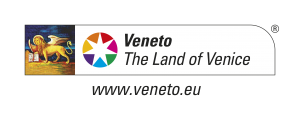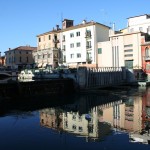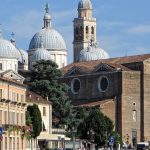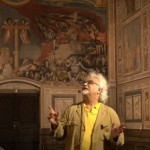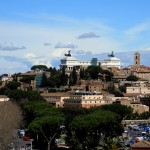A city designed by and on the waters
Padua on segway: Galileo’s Podium
Start your slow tour from the University where Galileo taught
Video full text: Galileo’s Podium
Lined up like that you look like Roman warriors on chariots! Are they technological chariots or what? It’s called Segway. It allows people to get around without moving their legs. It’s perfect for tourists. It’s not always possible to go by bike. Tourists normally wear themselves out. Whereas if they move around on a Segway they become superhuman. Is it difficult? Try it and we’ll see. Help, what now? It’s not as bad as I thought, it’s fairly intuitive. Are we ready then? Padua on the road, better still on Segways. Slow tour certainly, but technological. First stop: the University. I’m with Giulio Peruzzi, and we’re standing in front of this podium that made the history of physics. The piece of wood in itself didn’t make the history of physics. But the person who stood on it – it’s Galileo Galilei’s podium. We’re straddling the period between the 16th and 17th century. Galileo was in Pisa and at a certain moment came to Padua, where, as he said, he spent the 18 most beautiful years of his life. By why specifically Padua? At that time Padua was one of Europe’s most important universities. Galileo had the opportunity of taking a chair in mathematics here. He wanted the chair! He wanted this piece of rough wood. I expected it to be a little more lavish. This is only the supporting structure, and it would normally be covered with a drape. It’s not all there because next to the set of stairs, which one accesses from the right, there used to be a symmetrical one on the left. Whoever climbed onto the podium was really high up! At that time it was a way of seeing the professor as a light – the science preacher Galileo was a great teacher. When he taught they would pour into this room in their thousands. Huge numbers for those times. They weren’t just academics but ordinary people too who were swept away by his ability to put forward concepts that were not banal in a simple manner. This contrasted greatly with what was then the idea of the world. Which is why the Church found Galileo such a discomfort, because of his ability as an ex catedra populariser of science. No offence, but seen in this way it looks like a puppet theatre. It’s not as magnificent as most people imagine. Galileo, on the other hand, rented out rooms to students for living in and sold technical instruments. Galileo constantly had money problems; then, as now, university lecturers were not well paid. He had a family, a mother, children and a partner to support. Not a wife but a partner? That’s right, he never married. So one could say that modern science was born in Padua? Of course. In those times Padua was the crossroads for thinkers of great standing. Copernicus and Harvey also passed through here. Padua, the crossroads of modern science as a European movement. Galileo’s podium looks down on us from on high!
Produced in cooperation with the Official Tourist Board
Visit Padua: helpful hints
Italian name: PadovaArrival
Padua doesn’t have an airport. The nearest airport for international flights is the Venice Airport, but there is a bus leading directly to Padua (rides every hour, 8,5€). For transcontinental flights the nearest airport is the Bologna Airport. From the airport, first you have to reach Bologna Central Station by bus (rides every 15 minutes, it takes 30 minuts, 6€). From Bologna Central Station, both Trenitalia and Italo trains reach Padua in 50 minutes (ticket 10€, more or less).
Transports
You can visit Padua on foot or by bus. Single ticket costs 1,3€ and it lasts 75 minutes, more on FBus website.What to do
Padua is a stunning art city in Veneto region, close to Venice and Verona, in North Eastern Italy. It is famous for several art masterpiece that you simply must visit: start with the Giotto’s Scrovegni Chapel and Saint’s Anthony church. The University of Padua is one of the oldest and most important in Italy and in the whole Europe, here taught none other than Galileo Galilei and you can still visit its original Podium.
For a special break, look for the historic Caffè Pedrocchi and ask for their fine special caffè (a long espresso coffee with fresh mint cream and chocolate powder).
For more tips, watch the whole web serie we made about Padua and if you are fond of SPA tourism (or you just need some relaxing quality time) consider to spend some time on the Colli Euganei area, nearby. Pick one of the several SPA resort and enjoy the Roman baths and muds (try Abano Terme or Montegrotto Terme). From Padua, you can also reach easily many other interesting places, take a look to this itinerary through the amazing Palladian Villas of Veneto.

